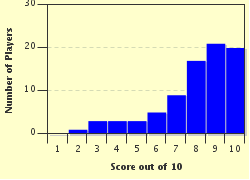Quiz Answer Key and Fun Facts
1. What is xeriscaping?
2. What does the Greek root of xer(os) mean?
3. In which of the following places would xeriscaping be least likely to be used?
4. Do xeriscaped plants need any water to live?
5. Do all xeriscapes look like a US Southwestern desert scene?
6. Must a xeriscape only use native plants?
7. Which of the following plants is least likely to be used in a xeriscape?
8. Which of the following types of grass is not suitable for a xeriscape?
9. Where did the term xeriscaping originate?
10. Does xeriscaping have to involve changing out all the plants in an existing landscape?
Source: Author
whee
This quiz was reviewed by FunTrivia editor
WesleyCrusher before going online.
Any errors found in FunTrivia content are routinely corrected through our feedback system.


